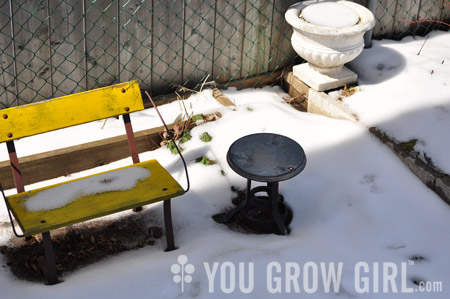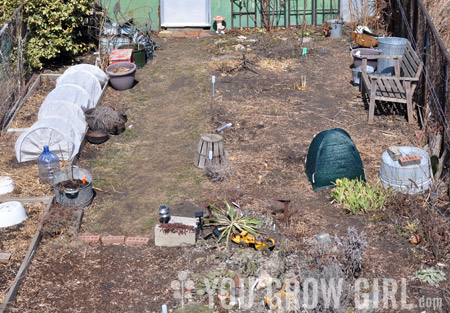
How much sun does it receive? That’s the first question we gardeners tend to ask ourselves when we start out to garden in a new space. It’s an important question for sure, but over the years, I have come to understand, that if you want to make the best use of your space, there are other, equally meaningful factors to consider.
Growing in the city, where heat-absorbing materials abound, my focus has often been on observing patterns of extreme heat. I earned my real gardening chops battling what I often refer to as Full Sun ++ for 15 years on the rooftop of my former apartment building. Times have changed and now I garden in a thin, bowling alley style urban backyard. Naturally, I spent the first winter carefully observing the way light fell onto the yard (throughout the day) in an attempt to identify how to tackle the space come spring. I also paid mind to heat, wind, drainage, soil, and the slope of my garden, and I have made adjustments over the last two seasons that address those issues or work best with them. Now that I am about to embark on my third spring in this garden, I have come to see with clarity that one condition that I had failed to fully acknowledge — probably out of habit — are the places in the garden that are the coldest.
What are Cold Spots?
In my Toronto garden, these are places where the snow and ice lingers the longest. While the rest of the garden is waking up from its winter dormancy, these cold microclimates remain asleep. In the fall, these also tend to be the spots that are hit first and hardest by the killing frost. Even if you live in a climate that does not receive a hard frost or snow, you will still have spots that are cooler and warmer than others.

This is most of the garden taken the same day that I took the photo at the top of the page. Notice the difference in conditions. The snowy part is in the shadow of the house and the lowest part of the slope. It is also the slowest to drain. It is by far the coldest part of the garden, while the rest is warm, fast-draining, and sunny.
What Factors Create Cold Spots?
Aspect: This is the slope of the land and the direction that slope takes. Here in the northern hemisphere, a slope that tilts south is warmer than one that faces north. My yard is north-facing, but the yard slopes significantly with the highest part of the slope where the sunlight hits most strongly throughout the day. As a result, most of the yard is quite warm, except the part that lies in the shadow of the house, which also happens to be the lowest part of the yard.
Exposure: Sun and wind. It only stands to reason that areas that receive a lot of strong sunlight throughout the day tend to be the warmest, and vice versa. Wind can have a strong cooling effect. However, areas with no air movement can be cooler when cool air is trapped and has no escape route out. Like many urban homes, there is a very narrow pathway between my house and the neighbour’s on one side. That corridor can act as a wind tunnel, sending strong, cold or hot winds directly at the bed that sits at the end of it. For that reason I have to be careful not to situate plants that are sensitive to windburn (such as Japanese Maples) in its path. Needless to say, I knew this immediately after moving in but guess what I have there? A Japanese Maple (albeit a particularly tough one). And yep, it does suffer leaf burn, especially in the summer when the wind is hot.
Materials that Absorb Heat: Brick walls, cinderblocks, concrete, and metal will all absorb heat and release it slowly at night. Areas of the garden that are surrounded by these materials, especially if they are hit directly by sunlight throughout the day, tend to be the warmest spots.
Height of the Bed: I mentioned aspect (slope + direction), but the actual height of the bed can affect temperature. I find that raised beds heat up more quickly in the springtime and stay a bit warmer later in the season. That said, I find that this condition is in part, connected with soil drainage (below) because raised beds also tend to have good drainage and dry out more quickly in the early part of the season.
Drainage: Areas where water drains more quickly tend to be warmer. However, too much drought can actually make plants more sensitive to the cold since stress conditions plus a lack of a healthy root system can make them more sensitive. This is just one reason why we organic food gardeners seek to build loamy, cake-like soil that is rich with organic materials — it helps support and encourage healthy root growth leading to stronger, more resistant plants.
Why Does This Matter?
Knowing now which spots in my garden are the coldest has prompted me to move certain plants that prefer to be woken up earlier in the springtime sun. In some instances I am making those changes simply because I want to see specific blooms earlier. As a food gardener, I want to extend my harvest for as long as possible, and have realized that perennial crops that are planted in the cool spots come up later in the springtime, and go dormant earlier in the fall. Early season crops like lettuce and salad greens grow more slowly there, but on the flip side they also last a little longer in the hottest months and tend to bolt much more slowly. As you can see, the cool spots can also be very useful!
Ways to Observe Hot and Cold Patterns in Your Garden
- Watch to see where the snow and ice lingers longest.
- Which parts of the garden wake up first? Which wake up later?
- Plant the same bulbs, seeds, or plants in different parts of the garden and observe where they come up first and last.
- Take soil temperatures regularly with a meat thermometer.
I have a one-third-acre property loaded with nooks and crannies leading to variables of heat, cold, light and moisture. It has taken me decades to discover the idiosyncrasies of each micro-climate and to match the preferred plants. I am getting better at it, though, and this theme is often mentioned when I advise other gardeners who seek plants which will thrive in specific conditions in their yards. Unwelcome Hurricane Sandy, October 2012, eliminated a large sheltered, shady area for me by felling an ancient blue spruce. Many perennials are scheduled to be moved out of the newly exposed full sun area. Extra vegetable crops will move in.
PS It’s been snowing here today since 8 am! I am ready to dig and Mother Nature is not cooperating.
If you’re a rural gardener your greywater pit and/or septic lines depending on they type of system you have will often be the first to defrost in the spring, sometimes months before the ground actually does. Here in southeastern BC mine is only covered in snow for the coldest parts of dec/jan
Good info. I discovered this year (we had loads of snow) that a part of area where I was planning a bed of sun loving perennials and some veggies was where the snow lasted longest. I’ll be keeping that in mind when I am ready to plant and keep the heat lovers out of that area. Our once weekly nor’easters this winter have taken out a lot of trees, so this summer may be hit or miss for some finicky plants.